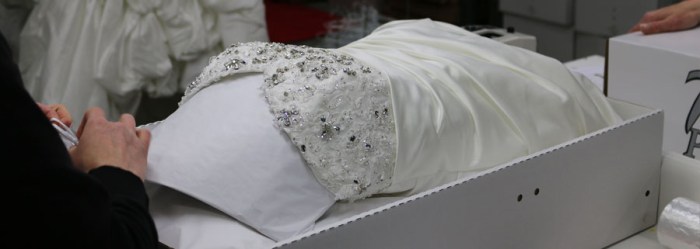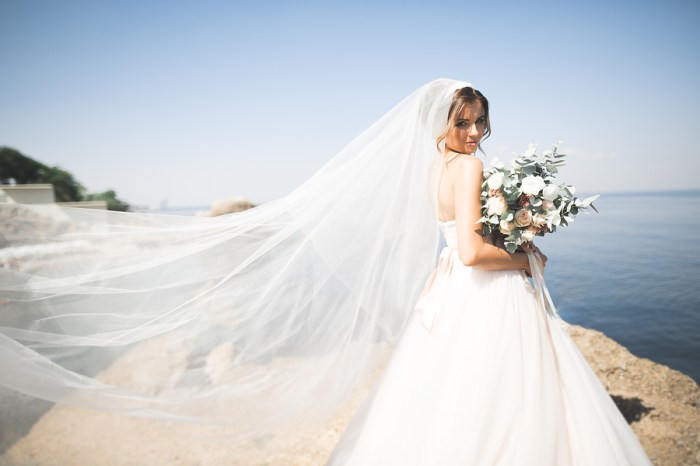Framed Wedding Dress Preservation A Guide
Understanding Framed Wedding Dress Preservation

Source: loveyourdress.ca
Framed wedding dress preservation – Preserving your wedding dress in a frame offers a unique and visually appealing way to cherish this cherished garment. This method showcases the intricate details and beauty of the dress while protecting it from damage. This section will delve into the process, materials, and techniques involved in framing a wedding dress.
The Process of Framing a Wedding Dress

Source: weddinggownpreservationkit.com
Framing a wedding dress involves carefully preparing the dress, selecting appropriate materials, and assembling the frame. The process begins with cleaning and preserving the dress, followed by mounting it onto a backing board using acid-free materials to prevent discoloration or damage. The framed dress is then carefully placed within the chosen frame, ensuring proper alignment and protection.
Materials Used in Framing a Wedding Dress
Several materials are crucial for successful wedding dress framing. Acid-free board is essential to prevent damage to the delicate fabrics. Acid-free tissue paper and archival-quality foam board provide additional protection and support. The frame itself can be made from various materials, each with its own advantages and disadvantages (discussed further below).
Framing Techniques for Wedding Dresses

Source: affordablepreservation.com
Different framing techniques exist, depending on the dress’s design and the desired aesthetic. Some dresses might require partial framing, showcasing only a section, while others might be fully framed, presenting the entire gown. The method of mounting the dress—whether using pins, adhesives, or a combination—also varies based on the fabric and embellishments.
Preparing a Wedding Dress for Framing
Proper preparation is vital for long-term preservation. This involves carefully cleaning the dress, addressing any minor repairs, and handling delicate fabrics and embellishments with extreme care. A systematic approach ensures the dress is ready for framing and minimizes the risk of damage.
- Gently brush the dress to remove loose dirt and debris.
- Spot-clean any stains using a professional dry cleaner’s recommended method.
- Handle delicate lace and beading with utmost care, avoiding pulling or tugging.
- Press the dress using a low heat setting and a pressing cloth to avoid scorching.
- Carefully inspect the dress for any tears or loose seams and make necessary repairs.
Choosing the Right Frame for a Wedding Dress
Selecting the appropriate frame is critical for both aesthetics and preservation. Consider the dress’s style, the size and weight of the garment, and the desired display environment when making your choice.
Factors to Consider When Selecting a Frame
Factors influencing frame selection include the dress’s style, size, and weight; the desired aesthetic; the display environment (humidity, light exposure); and the budget. The frame’s material also plays a significant role in preservation, as some materials offer better protection against environmental factors than others.
Frame Styles for Wedding Dresses
Various frame styles complement different wedding dress designs. A simple, elegant frame might suit a minimalist gown, while an ornate frame could complement a more elaborate design. The frame’s color and finish should also harmonize with the dress’s color palette and overall aesthetic.
Importance of Frame Size and Material
The frame’s size must accommodate the dress without causing undue stress or strain on the fabric. The material should be chosen for its durability, protection against environmental factors, and aesthetic appeal. Acid-free materials are crucial to prevent damage to the dress over time.
Comparison of Frame Materials
| Frame Material | Pros | Cons | Cost (Approximate) |
|---|---|---|---|
| Wood | Classic look, durable, versatile | Can be heavy, susceptible to warping in humid conditions | $$ |
| Metal | Lightweight, durable, modern aesthetic | Can be expensive, may scratch easily | $$$ |
| Acrylic | Lightweight, clear, protects from UV light | Can scratch, may yellow over time | $$ |
Preparing the Wedding Dress for Framing
Thorough preparation safeguards the dress’s integrity during the framing process. This includes cleaning, repairing any damage, and carefully handling delicate elements to avoid further damage.
Techniques for Cleaning and Preserving the Wedding Dress
Professional dry cleaning is recommended to remove dirt, stains, and odors. Delicate fabrics and embellishments require special handling and cleaning techniques. Avoid harsh chemicals or abrasive materials that could damage the fabric or trim.
Handling Delicate Fabrics and Embellishments
Lace, beading, and other delicate embellishments require careful handling. Use soft brushes and gentle cleaning methods to avoid damage. Any loose threads or beads should be carefully secured before framing.
Checklist for Preparing the Wedding Dress
- Professional dry cleaning
- Repair of any tears or loose seams
- Gentle cleaning of delicate embellishments
- Pressing (low heat, pressing cloth)
- Inspection for any further damage
Potential Problems and Solutions During Preparation, Framed wedding dress preservation
- Problem: Yellowing fabric. Solution: Professional cleaning and UV-protective framing.
- Problem: Loose beads. Solution: Secure beads with archival-quality glue.
- Problem: Tears in fabric. Solution: Professional repair by a seamstress.
Displaying and Maintaining the Framed Wedding Dress
Proper display and maintenance ensure the longevity and beauty of your framed wedding dress. Environmental conditions, protection from damage, and regular cleaning are crucial for preserving its condition.
Ideal Environmental Conditions
Avoid direct sunlight, high humidity, and extreme temperatures. A climate-controlled environment is ideal. Keep the dress away from heat sources, such as radiators or fireplaces.
Protecting the Framed Dress
Use UV-protective glass or acrylic to shield the dress from harmful light. Regularly dust the frame with a soft cloth or brush to prevent dust accumulation. Consider using a humidity control device in the display area.
Cleaning the Frame and Dress
Clean the frame regularly with a soft, dry cloth. Avoid using harsh chemicals or abrasive materials. For any significant cleaning of the dress itself, consult a professional conservator.
Preventing Damage from Pests and Environmental Factors
Regularly inspect the framed dress for signs of pest infestation. Use pest control measures as needed. Monitor the environmental conditions to prevent damage from moisture, temperature fluctuations, or light exposure.
Cost and Budget Considerations: Framed Wedding Dress Preservation
The cost of professional wedding dress framing can vary significantly depending on the chosen materials, techniques, and level of customization. Understanding the cost breakdown allows for informed decision-making and budget planning.
Typical Cost Range for Professional Framing Services
Professional framing services typically range from a few hundred dollars to several thousand, depending on the complexity of the project and the materials used. Factors influencing cost include the size and complexity of the dress, the type of frame, and any additional services required (e.g., cleaning, repairs).
Cost Comparison of Framing Materials and Techniques
Different materials and techniques impact the overall cost. Custom framing tends to be more expensive than using pre-made frames. High-quality materials and specialized techniques naturally increase the cost.
Saving Money While Ensuring Proper Preservation
Consider using less expensive but still archival-quality materials. DIY framing can save money, but requires careful attention to detail to avoid damaging the dress. Prioritize essential protective measures over expensive aesthetic choices.
Cost Breakdown for Wedding Dress Framing
| Item | Cost (Approximate) |
|---|---|
| Professional Cleaning | $50 – $200 |
| Materials (acid-free board, tissue, etc.) | $20 – $100 |
| Frame (wood, metal, acrylic) | $50 – $500+ |
| Professional Framing Services | $100 – $1000+ |
Alternative Preservation Methods
Framing isn’t the only method for preserving a wedding dress. Acid-free boxes and garment bags offer alternative approaches, each with its own advantages and disadvantages.
Comparison of Preservation Methods
Framing offers visual appeal but may not be suitable for all dresses. Acid-free boxes provide excellent protection but lack the visual impact of a framed display. Garment bags are a budget-friendly option but offer less protection than framing or acid-free boxes.
Advantages and Disadvantages of Each Method
Framing: Pros – visual appeal, protection from dust and light; Cons – cost, may not be suitable for all dresses. Acid-free boxes: Pros – excellent protection, relatively inexpensive; Cons – lack of visual appeal. Garment bags: Pros – inexpensive, easy to store; Cons – limited protection, may not be suitable for long-term storage.
Selecting the Most Suitable Preservation Method
Consider the budget, the dress’s design and fabric, and the desired level of protection when choosing a preservation method. For dresses with intricate details, framing might be preferable. For simpler gowns, an acid-free box might suffice. Garment bags are suitable for short-term storage or dresses with less delicate fabrics.
Visual Representation of Preservation Methods
Imagine three distinct visuals. The first shows a wedding dress elegantly framed, showcasing its details within a protective glass or acrylic enclosure. The second depicts the same dress carefully folded and stored within a sturdy, acid-free box, layered with protective tissue paper. The third shows the dress hanging gently within a clear, archival-quality garment bag, designed to prevent dust and wrinkles.
Top FAQs
Can I frame a wedding dress with beading or delicate embellishments?
Preserving your wedding dress in a beautiful frame is a cherished way to remember your special day. The decision on what to wear to the wedding itself is a different matter entirely, of course; consider the options available if the wedding is on a beach, such as the lovely selection of floral beach wedding guest dresses you might find online.
Returning to the preservation of your gown, a framed dress offers a unique and elegant display piece for years to come, a tangible memory to be proudly showcased.
Yes, but special care and techniques are required to prevent damage to these delicate features. A professional framer experienced with delicate fabrics is highly recommended.
How long does the framing process typically take?
The timeframe varies depending on the complexity of the dress and the framer’s workload, but it can range from several weeks to a few months.
What happens if my framed dress gets damaged?
Many professional framers offer insurance or guarantees against damage during the framing process or due to unforeseen circumstances. It’s crucial to inquire about this before commissioning the work.
Are there DIY options for framing a wedding dress?
While DIY is possible, it’s generally not recommended for delicate dresses. Professional framing ensures proper handling and preservation techniques are used, minimizing the risk of damage.

















